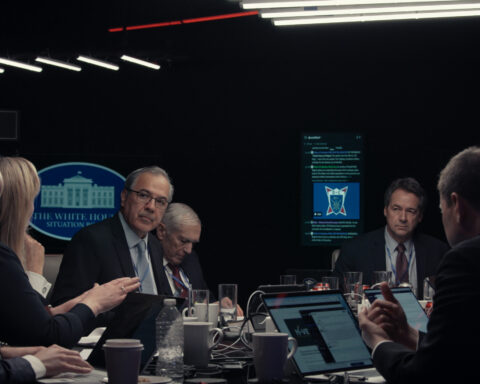Where to Invade Next
USA, 110 min.
Written and directed by Michael Moore
Programme: Special Presentations (World Premiere)
Reviewed by Patrick Mullen
Michael Moore summons a call to arms in his latest documentary Where to Invade Next. The provocative director tries a new tactic on the battlefield and it just might lead American to victory. Where to Invade Next already felt like a victory for the Toronto International Film Festival following the film’s thunderously enthusiastic World Premiere in September. Moore’s film surprises since his plan of attack veers from his sensationally confrontational tactics and instead offers a much gentler approach than one expects. There is no mistaking, though, that Where to Invade Next is very much a “Michael Moore film” as the shrewd filmmaker sweetly and humanely appeals to Americans to have a change of heart. Where to Invade Next might be Moore’s shrewdest move yet.
The game in Where to Invade Next is simple: show Americans how much the myth of the American dream fails them. A highly secretive production, Moore’s first effort shot entirely outside of the USA, shows him visiting countries with largely comparable levels of comfort to America. He invades them, but not the good old-fashioned American way, with guns and bombs. He invites dialogue. He listens. He takes notes. He learns.
Where to Invade Next takes the concept of “guerrilla filmmaking” to another level as Moore’s invasions bring him to countries like Italy where a married couple talks about their extended vacation time, paid parenthood leaves, and other legislated benefits make Italians, to use Moore’s words, always looking like they just had sex. Moore listens attentively and then asks his Italian friends what they think of America’s offer of guaranteed vacation time: zero weeks. The shock and disbelief on their faces is amusing. The gap seems incomprehensible to both them and Moore, just as it does to their employers who articulate an un-American business strategy by emphasizing the happiness of the employee and the strength of the employer/employee relationship as ideal business goals. Moore even gets a meeting with a manufacturing executive on the assembly floor, something that’s eluded him since Roger & Me. As Moore plants an American flag and claims Italy’s philosophy of paid leave and vacation, he marks a firm full stop on the joke/truth that Italians are ultimately more productive even with their slower, happier pace.
Similarly, a visit to Finland highlights the benefits of changing a philosophy on education by eliminating homework and emphasizing the social and personal needs of the children. If the children of America spent their time being active, social, and relaxed, rather than doing work they should be doing during the school day, argues Moore, they’d have the skills, confidence, and charity to lead America to a brighter future.
Moore’s trip to Slovenia reveals the benefits of free university education. Rather than leave school with debt, Slovenian students graduate with an education and no baggage. As it always seems to happen to him while travelling, Moore encounters a handful of American students who attend school in Slovenia because the American system failed them. Where to Invade Next demonstrates that America risks an exodus of the bright stars of the future if the country fails to adapt to the needs of the current generation.
The funniest sequence of the film takes Moore to France where he savours the delectable lesson of an elementary school cafeteria. Whereas American schools serve a diet of freedom fries, mystery meat, and pizza (if the students need a vegetable), the French schools offer elementary kids a four-course meal fit for a king. (The school Moore visits stocks eighty varieties of cheese.) The difference, though, is that the school treats lunch as a class rather than as a business strategy. Kids learn the importance of a healthy balanced diet as they savour lamb with couscous and share cheese plates. They drink water instead of sugary pop. (Moore offers some kids some sugary contraband at the lunch table and they eye him suspiciously as if he’s a stranger with candy.) Lunch also teaches the kids the importance of community in addition to enhancing their palettes. When Moore shows the staff and students what kids eat in America using photos supplied by the child of a crewmember, the kids react with shock and awe. “This isn’t food,” the school chef says. “I feel sorry for them.” Moore, in his signature sarcastic humour, says that America has it bad if even the French offer sympathy.
Moore stamps his passport in other countries like Germany, Norway, and Tunisia, and his travels offer lessons in alternative strategies to America’s broken system. In each sequence, Moore plays the role of the ignorant American tourist and asks with droll exaggeration how the men and women of these countries weigh the costs and benefits of their social rewards. He then juxtaposes each sequence with reflective archival footage that contextualizes the American dilemma when dealing with the inequalities addressed in each chapter.
It takes a lot of courage to look at the country one loves and directly address the deep-rooted failures at the heart of the nation. Moore draws upon themes and subjects of his previous films, such as the failings of capitalism, America’s penchant for violence, and its fondness for valuing dollars over human lives, but Where to Invade Next pleads a strong case to both the heart and the head. The film doesn’t deliver the same sensationalism that, for better or for worse, defines Moore’s films, but his unshakable pride in America rings true in every interview as he scours the globe looking to save the country he loves. This kinder, gentler Moore offers an extension in the effective sentimental side that creeps through in Capitalism: A Love Story. With Moore’s mix of sarcasm and sweetness, the film reveals the absurdity of American ideology through humour and by visiting the countries that are getting it right.
Call it a shift in ideology, a change in values, or simply practical thinking, but Michael Moore seems tired of being angry. Anger, Moore shows, doesn’t change things. It makes headlines, provokes trending topics, and ultimately incites tipping points, yet Moore’s global gaze shows that the countries he visits progressed by approaching their citizens from a humanist perspective. A positive reaction, Moore implies, Trumps a negative one, and America’s time of being the parent who always says “no” needs to end. Moore’s choices of locales are admittedly romantic, but by asking audiences where to invade next, the filmmaker offers an idealized society to which his countrymen may aspire. Moore delivers as much humour and unexpected blows in Where to Invade Next as he does in his other films, but the global and emotional scope of his argument in his latest film is one of his finest achievements. Perhaps Moore’s infectious optimism is the biggest shock of his career.
Where to Invade Next had its World Premiere at the Toronto International Film Festival on September 10 at the Princess of Wales Theatre.
Please visit www.tiff.net.ca for more information on this year’s festival.

Photo courtesy of TIFF.











